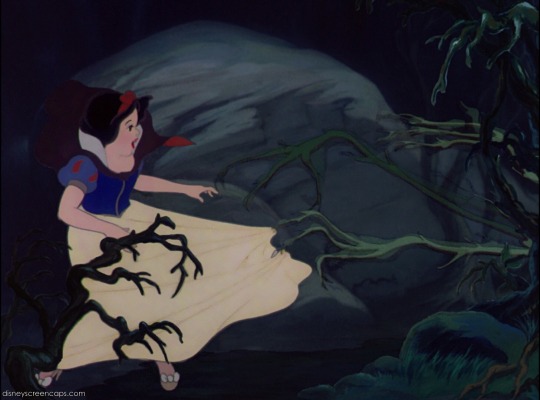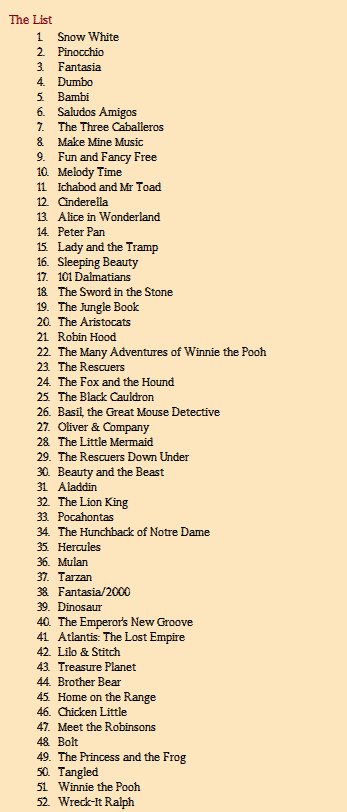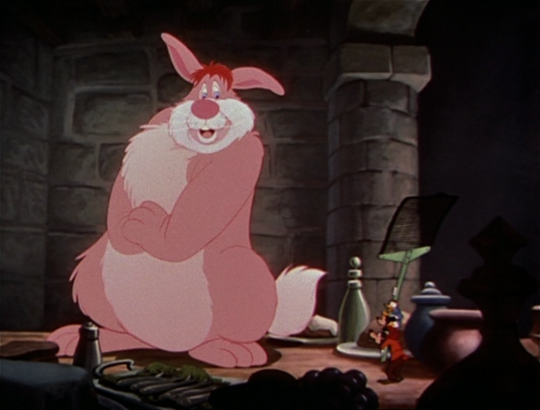 This review contains mild spoilers for The Black Cauldron but don’t let that put you off reading it – this film needs to be seen to be believed.
This review contains mild spoilers for The Black Cauldron but don’t let that put you off reading it – this film needs to be seen to be believed.
There’s a reason that on the rather inconsistent checklist that I have in every Disney52 post there is the ‘traumatic’ category. Disney have terrified audiences ever since Snow White fled into the seemingly demon infested woods, and many of their best films have really scary or bizarre moments. Some of the most effective scares are sustained sequences where things just get more horrific, such as Pinocchio fleeing the satan-whale or the dance of the damned in Fantasia. The other kind of scare most regularly used by the House of Mouse are the baffling, strange moments of surrealism that are so out of this world that it becomes deeply unnerving. Remember Pink Elephants on Parade? Just look below at some of the screenshots from their Golden Age films that may just terrorise your nightmares.
The Black Cauldron, the first of Disney’s feature animations to get a PG rating, is the strangest, scariest Disney yet, full of moments that will either leave your jaw on the floor or your trousers in a mess. It has the sequences of sustained terror that are there to create pure fear, and the surrealist horror that will screw with your brain like a bad drug trip. If you want to know why The Black Cauldron flopped commercially then take a look at the villain’s introduction – a robed, skeletal creature broods in a tower surrounded by the skeletons of dead warriors as he schemes to bring them all back to life to kill the mere mortals he is surrounded by. Maleficent was scary, this is a whole new level of terrifying. It just gets worse, as well, as the adventure continues with witches, sorcery and said undead army that swarm out into the black landscapes of this alien world. The Black Cauldron is the kind of thing that will scare audiences of all ages, so you can understand why Mum and Dad weren’t rushing to buy their kids tickets back in 1985.
The plot in itself is baffling and weird. Taran is a kid that looks after a pig, Henwin, who turns out to be a magical prophetic pig. That’s right, the Maguffin is a pig. Said porcine is then kidnapped by the villain who wants to find the location of a Black Cauldron that can raise an army of skeletal soldiers. Taran goes to rescue the pig but is captured instead and put in a tower where he meets Princess Eilonwy – who is followed around by a magic bauble – and the old bard Fflewddur Fflam. He finds a magical sword that can defeat just about any enemy. They visit some fairies where they are reunited with the thaumaturgical hog, go and visit some witches who give them the Black Cauldron which they then use to try and defeat the big hornèd one, but they accidentally set off some kind of green misty vortex that acts like a vaccum that can only be stopped by someone voluntarily dying in it. This is just scratching the surface of the relentless bizarreness of this film.
The whole thing is just so strange. There’s an indeterminate creature named Gurgi who sounds like Gollum and occasionally follows this mismatched group of friends around. By the end he sacrifices himself by throwing his little furry body to certain death within the cauldron (yes, this is a Disney film). The bard that joins the merry crew has a lyre that apparently snaps its strings whenever the singer tells a lie. This is never really explored, it’s just assumed. There’s a brief and unexplained foray into the world of fairies that live beneath a well (I think?) that doesn’t serve much of a purpose. Perhaps this narrative oddness is because the film is based on far richer source material, The Chronicles of Prydain by Lloyd Alexander, so it only shows glimpses of a world that had previously been expanded upon over five books. In that way it could be like the early Harry Potter films, jumping between events and parts of the world without really explaining them.
Much of the stilted nature of the storytelling can be attributed to the arguments that went on in the production, with Jeffrey Katzenberg falling out with Michael Eisner over the edit of the film. The version we don’t get to see had a fleeing Eilonwy with ripped clothes, more of the fairy world and an undead soldier slicing someone up the torso. Getting rid of such scenes leads to a jarring continuity, and the troubled production occasionally shows in the finished product (Katzenberg, not long for the studio, was apparently disappointed with it). You can see why this was such a contentious film, and also why it isn’t as famous as, well, most other Disney films.
Yet here’s the thing – The Black Cauldron is the least Disneyish of the lot and it is certainly the strangest and scariest in the canon, but this isn’t necessarily a bad thing. There’s a lot to enjoy about The Black Cauldron, even if it’s not quite as family friendly as some of the studio’s more famous films. The animation isn’t great – more Saturday morning TV cartoon than some of their more artistically accomplished films – but there’s something charmingly rustic about the look of it. The unashamed fantasy setting is a fascinating one for Disney to explore, the old crumbling castles and magical swords apparently inspired by Welsh mythology. It’s also, to use a reviewing cliché, something of a rip-roaring adventure, flitting from event to event and never really letting up the pace. It doesn’t all work (the fairies section feels especially unnecessary), but this is often exciting and different. Princess Eilonwy, meanwhile, is the most interesting Princess so far, so naturally isn’t in the range you can buy in the Disney stores.
The Black Cauldron is a curiosity, perhaps a film more for completionists than casual fans, but it is undoubtedly a fascinating film. It’s full-on fantasy, and it embraces that at the cost of accessibility and enjoyment for younger audiences. A unique experience.
 It’s time to talk about the role of a voice-over in film. I’ve mentioned before my love of Terrence Malick, and I think his films are examples of how a non-diegetic narration can perfectly encapsulate the themes and mood of a film. The whispers of The New World and the naïve storytelling of Badlands are mesmerising, layered with meaning that takes several viewings to properly grasp. Yet it’s not just Malick that uses voice-overs in this way; most recently Beasts of the Southern Wild had a memorably precocious, philosophical narrator in the form of Hushpuppy. The problem is, this highly effective tool can be misused, simply employed as an editing technique when your story doesn’t make much sense without it. It can also, as in the case of Fun and Fancy Free as well as other early Disney films, be an intensely patronising device, spelling out the exact action that we can already see on screen. A classic rule of storytelling – show, don’t tell – is broken repeatedly by an overly intrusive voice-over.
It’s time to talk about the role of a voice-over in film. I’ve mentioned before my love of Terrence Malick, and I think his films are examples of how a non-diegetic narration can perfectly encapsulate the themes and mood of a film. The whispers of The New World and the naïve storytelling of Badlands are mesmerising, layered with meaning that takes several viewings to properly grasp. Yet it’s not just Malick that uses voice-overs in this way; most recently Beasts of the Southern Wild had a memorably precocious, philosophical narrator in the form of Hushpuppy. The problem is, this highly effective tool can be misused, simply employed as an editing technique when your story doesn’t make much sense without it. It can also, as in the case of Fun and Fancy Free as well as other early Disney films, be an intensely patronising device, spelling out the exact action that we can already see on screen. A classic rule of storytelling – show, don’t tell – is broken repeatedly by an overly intrusive voice-over.
A lot of what made Bambi a great film, for instance, was that the images largely spoke for themselves. Here, there seems to be a lack of confidence in the story, so the filmmakers rely on voice-over to add to it. It’s also a much cheaper option; much less synchronisation is required with a voice-over than with dialogue, so a lot less time is spent on the film and it ends up being a more cost efficient way of making it. The cheapness shows, and the stories lose any kind of impact because of it.
In Fun and Fancy Free, at least, there is more of a story than Saludos Amigos or The Three Caballeros which also suffered from constant, heavy handed narration. There are two separate stories, linked only by some Jiminy Cricket filler scenes (why did they bring him back? Hardly their greatest character). The first is called ‘Bongo’, about a bear who breaks out from his circus to live in the wild, where he falls in love. The second is Jack and the Beanstalk retold with Mickey Mouse (played for the last time by Walt Disney himself), Goofy and, sadly for everyone, Donald Duck. Neither are especially good, largely due to the terrible interference by the storytellers. It means the film as a whole is largely forgettable.
Forgettable except, that is, for its downright strangeness. Yes, Fun and Fancy Free could be the most bizarre Disney film yet, and not in a good way. It’s full of creative decisions that baffle the mind, and makes one wonder at what stage in the boardroom everyone just gave up and went nuts. Here are five of the strangest moments, four of which are from the Jack and the Beanstalk story. The bear one was a lot blander.
-
The giant’s desire to be a giant pink bunny rabbit
The crux of Disney’s version of Jack and the Beanstalk is that the three ‘heroes’ end up stealing from a mentally impaired giant who only stole the singing harp because of crippling insomnia. He’s a gentle soul, really, as demonstrated by this moment where he reveals his desire to use his magic to transform into a giant pink rabbit. No explanation given and, I think, no explanation needed.
-
These creepy puppet narrators who are at a party with a young girl being told a story by an old man.

- It’s sad when your only friend is a puppet.
Mortimer and Charlie are two puppets who, alongside an old man, appear to be the only guests invited by a very 1940s little blond American girl. Mortimer is apparently depressed and has limited imaginative capacities, Charlie is a hard bitten cynic who makes wisecracks during the story. Charlie’s suggestion as to how Mickey, Donald and Goofy should get of poverty is to eat their friend Daisy the cow. This raises all sorts of questions anyway – why are cows livestock, but mice, dogs and ducks are people who live in a house? Why is it ok to sell a cow but not Donald? Can someone please kill Donald? – but also reveals Charlie to be something of a sociopath. One quick glance at his dead eyes and wooden frame and you know this to be true.
-
A song that perhaps endorses domestic violence
How do bears express love? According to Disney, it’s by slapping their partners. This is demonstrated by a long dance, to a song telling us that ‘a bear likes to say it with a slap’. It’s immensely disconcerting to see one bear slap another, then hearts appear around their heads. The conclusion to this segment of the film is one man bear slapping a woman bear in the face, then the two of them ride off together on his unicycle.
-
This surprisingly meta moment at the end.
Mortimer the puppet is crying because he sympathises with the educationally challenged giant, who has apparently died. At this point the storyteller reassures him: “What you don’t understand is that the giant didn’t actually exist! He’s a metaphysical phenomenon of your subconscious mind; a phantasmagoria of your mental faculties. In other words, just a figment of your imagination!”
This doesn’t make any sense at the best of times, but the strangeness of the situation is promptly exacerbated by the giant tearing the roof off the house where the puppets and creepy blond child have just been told that said giant doesn’t exist. He then puts the roof down and walks off into the distance, and the film ends. Given how meta-narratives are very post-modern, such audacity seems ahead of it’s time. Perhaps Fun and Fancy Free is actual a pre-post-modern masterpiece.
-
A puppet’s moment of existential crisis
Charlie, the jokesome puppet who keeps chipping in his two cents on the story, gets a little too silly for the old man who is narrating. The old man is then surprisingly brutal, leading to this baffling exchange:
Old Man: “Aren’t you ashamed of yourself, Charlie? Why do you act like that?”
Charlie [folorn]: “I don’t know… I guess it’s just a stage I’m going through.”
Old Man: “Now take off this moustache and go and sit over there.”
Charlie: “Yes, sir. Everything I do is wrong…”
Reports say that the puppet hanged himself days later.














